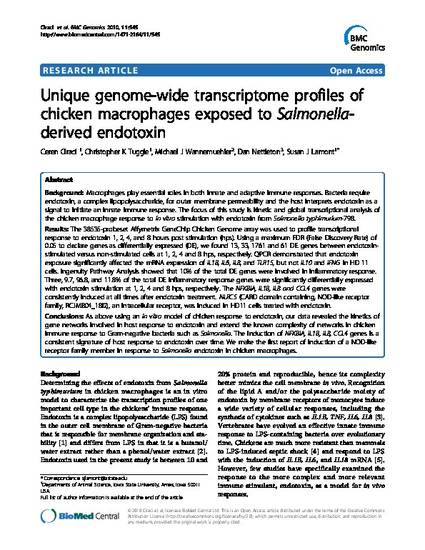
Background: Macrophages play essential roles in both innate and adaptive immune responses. Bacteria require endotoxin, a complex lipopolysaccharide, for outer membrane permeability and the host interprets endotoxin as a signal to initiate an innate immune response. The focus of this study is kinetic and global transcriptional analysis of the chicken macrophage response to in vitro stimulation with endotoxin from Salmonella typhimurium-798.
Results: The 38535-probeset Affymetrix GeneChip Chicken Genome array was used to profile transcriptional response to endotoxin 1, 2, 4, and 8 hours post stimulation (hps). Using a maximum FDR (False Discovery Rate) of 0.05 to declare genes as differentially expressed (DE), we found 13, 33, 1761 and 61 DE genes between endotoxinstimulated versus non-stimulated cells at 1, 2, 4 and 8 hps, respectively. QPCR demonstrated that endotoxin exposure significantly affected the mRNA expression of IL1B, IL6, IL8, and TLR15, but not IL10 and IFNG in HD 11 cells. Ingenuity Pathway Analysis showed that 10% of the total DE genes were involved in inflammatory response. Three, 9.7, 96.8, and 11.8% of the total DE inflammatory response genes were significantly differentially expressed with endotoxin stimulation at 1, 2, 4 and 8 hps, respectively. The NFKBIA, IL1B, IL8 and CCL4 genes were consistently induced at all times after endotoxin treatment. NLRC5 (CARD domain containing, NOD-like receptor family, RCJMB04_18i2), an intracellular receptor, was induced in HD11 cells treated with endotoxin.
Conclusions: As above using an in vitro model of chicken response to endotoxin, our data revealed the kinetics of gene networks involved in host response to endotoxin and extend the known complexity of networks in chicken immune response to Gram-negative bacteria such as Salmonella. The induction of NFKBIA, IL1B, IL8, CCL4 genes is a consistent signature of host response to endotoxin over time. We make the first report of induction of a NOD-like receptor family member in response to Salmonella endotoxin in chicken macrophages.
Available at: http://works.bepress.com/dan-nettleton/75/

This is an article published as Ciraci, Ceren, Christopher K. Tuggle, Michael J. Wannemuehler, Dan Nettleton, and Susan J. Lamont. "Unique genome-wide transcriptome profiles of chicken macrophages exposed to Salmonella-derived endotoxin." BMC genomics 11 (2010): 545. doi: 10.1186/1471-2164-11-545.